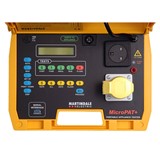At an event reviewing progress in 2009 of the UniSA-based CRC for Contamination Assessment and Remediation of the Environment (CRC CARE), industry spokesman David Browne, Coffey Environments Global Leader, said that Adelaide was in a unique position to build this business.
"The State has two specialised and well-equipped research groups in cleaning up soil, water and air located together in new purpose-built laboratories on the Mawson Lakes Campus of UniSA," says Browne.
The CRC, with a national established funding base, is already a research leader in this field with over 50 projects across Australia and China.
The other group, CERAR (the Centre for Environmental Risk Assessment and Remediation), is part of UniSA. It preceded the CRC and works closely with it.
"These groups, together with their collaborators, already include some of the world’s best-known researchers in the specialised work of contaminated site assessment and remediation," Browne said. "They are also training the pool of young scientists that this emerging industry will need."
The private sector also has several large players in South Australia, such as Coffey Environments, well placed to apply research outcomes throughout Australia and SE Asia.
Managing director of CRC CARE, professor Ravi Naidu, said that the CRC's 58 PhD students covered all aspects of clean-up science, from arsenic-eating bacteria to innovative filtering media. While most of the supervision was happening at UniSA, its students were also based at the Curtin University of Technology, the University of Queensland, Southern Cross University (in Lismore, NSW), the University of Technology, Sydney, and James Cook University in Townsville. Eight of the PhD students are in China.
In addition to tertiary training, the CRC also runs workshops and short courses for personnel already working in the industry. Training events this year included asbestos, petroleum hydrocarbons, site assessment, and testing for contaminants from the use of older types of fire-fighting foam.
The meeting was also told that the Department of Defence and the mining industry were two of the CRC's largest partners and investors. These sectors, of course, also have a high economic profile in SA, and both are growing strongly.
"The research base here in SA has already shown it is able to service the national needs of large organisations like the Department of Defence and BHP-Billiton Iron Ore Pty Ltd in assessing contaminated sites and developing an appropriate science-based response," Professor Naidu said.
Another SA link was the headquarters in Adelaide of the National Environment Protection Council (NEPC), which administers the Commonwealth Government's powers to make National Environment Protection Measures (NEPMs). These involve matters such as air and water quality standards, noise, hazardous wastes, recycling, as well as guidelines for the assessment of site contamination.
"The CRC already works closely with NEPC, providing scientific advice on issues such as groundwater pollution with petroleum products," Professor Naidu says.
"There is a good and positive understanding about what NEPC needs and what the science base here in SA can provide. It is easy to deal with NEPC with their office here in Adelaide, and I know that NEPC feels it is getting what it needs from us."
Finally, the expertise base in SA extends to environmental legislation, with the CRC having recently launched a new national website that allows users quick access to legislation on contamination and remediation in Australian jurisdictions. This is vital information for consultants and developers as they seek to conform to the legal requirements governing their job sites.
Contained in a fully searchable online database, this is the first legal resource of its type in the world. Over 300 users from 12 countries have now registered to use the site ( www.cslawpolicy.com/).
"We are extending this cover to include legislation in the US, Europe and Asia," Professor Naidu said. "It will be a unique global resource, and it has been created here in SA."
SA is also the home of the new Australian Remediation Industry Cluster (ARIC), also managed by the CRC, which seeks to facilitate information flow within the industry and between industry practitioners and researchers. ARIC launched its new website Remediation Australasia (www.remediationaustralasia.com.au) at the international conference CleanUp09 held in Adelaide in September.
"Overall the location here in SA has an array of economic, institutional and research advantages that put the State in an excellent position to lead Australia and the region in the provision of clean-up advice and services," Professor Naidu said.
"Both government and industry need to recognise this opportunity and get behind the creation of a new science-based, high-tech green industry for this State," he said.
- Suppliers
- New to IndustrySearch? Book a Demo
- Advertise with us
- Login
- Email Marketing
- Buyers
- Get Quotes
- Articles & Ideas
- Login
- Subscribe to newsletter
- My Details
- Get Quotes
- Automation & Control
- Automotive Workshop Equipment
- Commercial Cleaning Equipment & Supplies
- Construction Equipment & Heavy Machinery
- Conveyor Systems & Components
- Electrical & Power Generation Equipment
- Electronic Components
- Farming & Agriculture
- Food & Beverage Processing
- Forklifts & Forklift Attachments
- Hydraulic & Pneumatic Equipment
- Industrial Materials, Tools & Components
- Industrial Pumps
- IT Hardware & Industrial Computing
- IT Software & Applications
- Laboratory Equipment & Instruments
- Manufacturing & Industrial Equipment
- Material Handling & Lifting Equipment
- Metalworking & Machining
- Mining Equipment & Machinery
- Packaging & Labelling Machinery
- Pallet Handling Equipment
- Personal Protective Equipment
- Security & Surveillance
- Test & Measurement
- Transport & Logistic Equipment
- Warehouse Storage, Shelving & Racking
- Waste Treatment & Environmental Management
- Welding Machines & Accessories
- Woodworking & Joinery Machines
- Workplace Equipment
- Workplace Safety Equipment
- Get Quotes
- Automation & Control
- Automotive Workshop Equipment
- Commercial Cleaning Equipment & Supplies
- Construction Equipment & Heavy Machinery
- Conveyor Systems & Components
- Electrical & Power Generation Equipment
- Electronic Components
- Farming & Agriculture
- Food & Beverage Processing
- Forklifts & Forklift Attachments
- Hydraulic & Pneumatic Equipment
- Industrial Materials, Tools & Components
- Industrial Pumps
- IT Hardware & Industrial Computing
- IT Software & Applications
- Laboratory Equipment & Instruments
- Manufacturing & Industrial Equipment
- Material Handling & Lifting Equipment
- Metalworking & Machining
- Mining Equipment & Machinery
- Packaging & Labelling Machinery
- Pallet Handling Equipment
- Personal Protective Equipment
- Security & Surveillance
- Test & Measurement
- Transport & Logistic Equipment
- Warehouse Storage, Shelving & Racking
- Waste Treatment & Environmental Management
- Welding Machines & Accessories
- Woodworking & Joinery Machines
- Workplace Equipment
- Workplace Safety Equipment
Trusted by 1,000,000+ Australian industrial buyers
Buyers
- Discover products & solutions
- Login
- Subscribe To Newsletter
- Browse All Products
- Read Articles
Suppliers
Advertise
- Promote your products & solutions
- New to IndustrySearch? Book a Demo
- Login / Forgot Password
- Advertise Your Products
- Success Stories
- Email Marketing
- Suppliers
- Advertise with us
- Login
- Email Marketing
- Buyers
- Get Quotes
- Articles & Ideas
- Login
- Subscribe to newsletter
- My Details
Get Quotes
- Automation & Control
- Automotive Workshop Equipment
- Commercial Cleaning Equipment & Supplies
- Construction Equipment & Heavy Machinery
- Conveyor Systems & Components
- Electrical & Power Generation Equipment
- Electronic Components
- Farming & Agriculture
- Food & Beverage Processing
- Forklifts & Forklift Attachments
- Hydraulic & Pneumatic Equipment
- Industrial Materials, Tools & Components
- Industrial Pumps
- IT Hardware & Industrial Computing
- IT Software & Applications
- Laboratory Equipment & Instruments
- Manufacturing & Industrial Equipment
- Material Handling & Lifting Equipment
- Metalworking & Machining
- Mining Equipment & Machinery
- Packaging & Labelling Machinery
- Pallet Handling Equipment
- Personal Protective Equipment
- Security & Surveillance
- Test & Measurement
- Transport & Logistic Equipment
- Warehouse Storage, Shelving & Racking
- Waste Treatment & Environmental Management
- Welding Machines & Accessories
- Woodworking & Joinery Machines
- Workplace Equipment
- Workplace Safety Equipment
Get Quotes
- Automation & Control
- Automotive Workshop Equipment
- Commercial Cleaning Equipment & Supplies
- Construction Equipment & Heavy Machinery
- Conveyor Systems & Components
- Electrical & Power Generation Equipment
- Electronic Components
- Farming & Agriculture
- Food & Beverage Processing
- Forklifts & Forklift Attachments
- Hydraulic & Pneumatic Equipment
- Industrial Materials, Tools & Components
- Industrial Pumps
- IT Hardware & Industrial Computing
- IT Software & Applications
- Laboratory Equipment & Instruments
- Manufacturing & Industrial Equipment
- Material Handling & Lifting Equipment
- Metalworking & Machining
- Mining Equipment & Machinery
- Packaging & Labelling Machinery
- Pallet Handling Equipment
- Personal Protective Equipment
- Security & Surveillance
- Test & Measurement
- Transport & Logistic Equipment
- Warehouse Storage, Shelving & Racking
- Waste Treatment & Environmental Management
- Welding Machines & Accessories
- Woodworking & Joinery Machines
- Workplace Equipment
- Workplace Safety Equipment
Trusted by 1,000,000+ Australian industrial buyers







